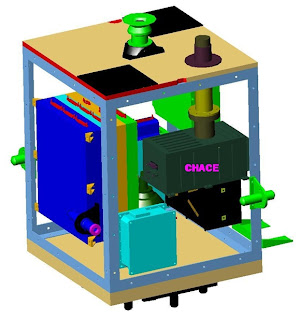It was just around the same week last year (2009) that the team of Moon Mineralogy Mapper (M3) of NASA had called for a press meeting in Washinton, DC to announce their finding of water on the Moon. I had to swallow the bitter pill of reality where in we couldnt convince the international scientific community (by then) about our results (CHACE-payload) of water finding on the moon way back in 14th November, 2008 and hence couldnt make it to the public as late as March, 2010, Planetary and Space Sciences, 58, 947-950, 2010.
Here comes the recent approval by the international scientific community where the same data acquired during the Moon Impact Probe mission of chandrayaan has now been accepted. We got our second land mark paper accepted by the British journal, Planetary and Space Sciences, 58,1567-77, 2010. It is as if that the present CHACE data is sitting pretty somewhere close to Malapert Mountain on the southern Lunar pole. We are now alone, nobody can touch these first time results on the 1-100 amu mass range; so its our turn to tell the world that whatever has been achieved on 14th November, 2008 indeed was spectacular; in the sense that the meticulous planning of designing this marvel called CHACE and flawless mission (Chandrayaan) to the moon and finally the sweet results were all here to celebrate.
 |
| CHACE payload |
It was a team effort of around 5-6 hand picked dare-to-dream members who are ready to take any challenge in their way with zero experience in space related instrumentation. We were ably guided by a senior scientist who had gone through quite a few roller coaster rides in the space borne instrumentation. It was due to his vision and of course like a ocean the Indian federal agency ISRO was giving support on all front that we could achieve the most impossible of sniffing the lunar environment during its day time.
Having got the CHACE paper on water published in Planetary and Space Sciences; we completed all the detailed data analysis of the entire spectra (600 Plus) we procured by CHACE and this time had no difficulty in convincing the peer review committee on the credibility of our instrument. As a project manager of this payload, I stick my neck and like to inform that we took utmost care in avoiding all the glitches which could have hampered the quality of our data. We read every bit of literature available in the open forum, even consulted the Apollo team members (private communication with Dr. Bob Hodges) and got the views from the latest reviewer on lunar composition (Alan Stern, Rev.of GeoPhy, 1999, 453) before freezing the instrument parameters. We knew exactly, what could have been wrong with the Apollo instrument, LACE which survived for 8-plus months but couldnt acquire the data the moment sun was rising on the lunar horizon. In a way, we are thankful to the entire human kind which has been striving to unravel the secrets of our closest heavenly body. I am sure in the time to come, all the future missions to moon certainly will follow what has been learned from this observations.
Let me briefly explain how we collected the data on the Moon Impact Probe (MIP) Mission on 14th November, 2008. We had planned for a pre-mission test by switching on the three payloads (1. Moon Imaging system, 2. Radar Altimeter, 3. CHACE) of MIP 4-orbits prior to the actual MIP mission. The payloads performed normally, while CHACE collected 136 spectra during this trial run. On the actual mission, the three payloads were turned on 20-minutes before the MIP separation from the mother space craft, after the separation the MIP had taken another 24-minutes descend journey to its final plunge near the Malapert Mountain in the southern pole of the moon (89S, -30W). Hence, CHACE had a total of 44-minutes of mission time during which it collected 600-spectra in the mass range of 1-100 amu for every 4-seconds.
 |
| CHACE data just before and after the separation of MIP from the mother space craft |
The above figure shows two spectra acquired while the CHACE is still attached to the MIP and the second is just after the separation. The peak just before 20 amu (no.18) is that of water while the peak at 44 COULD BE DUE TO CO2. It is interesting to note that the spectra remain exactly same during the pre and post separation, indicating that neither the out gassing from the nearby sub-systems of the spacecraft nor the firing of de-orbit motor has played any in role in the CHACE observations. As a matter of fact, it is all due to the placement of CHACE probe (ion source) location which is protruding out of MIP and it (probe) is the first to sample the environment as MIP descends.
 |
| Moon Impact Probe (MIP) |
My intention here is to make this presentation on a popular level and to convey to the world that our baby, CHACE indeed did its job much much more than anybody's expectations. At the end of the day, the CHACE team is content with what they have achieved; however, on my personal behalf, feeling very soar for losing the credit of observing water much before than the other instruments on Chandrayaan-I could even be operational.
My recent BLOGS: (Jan: 2014)
